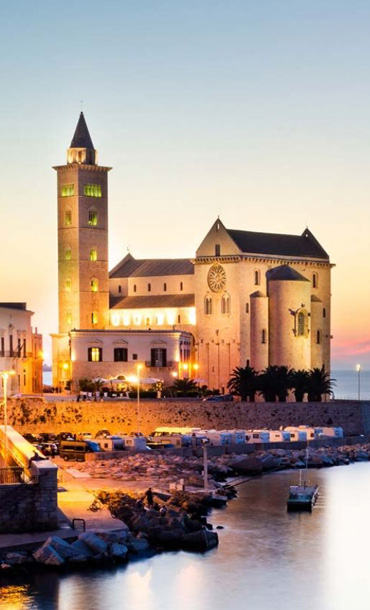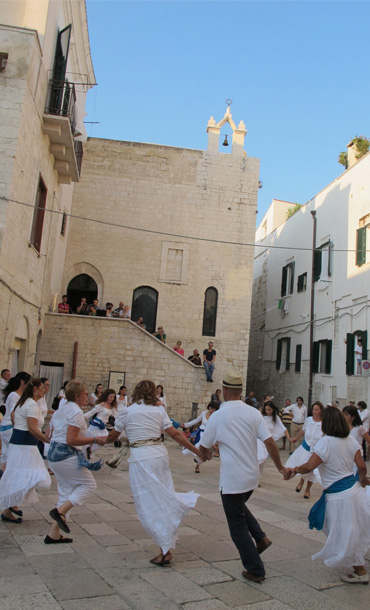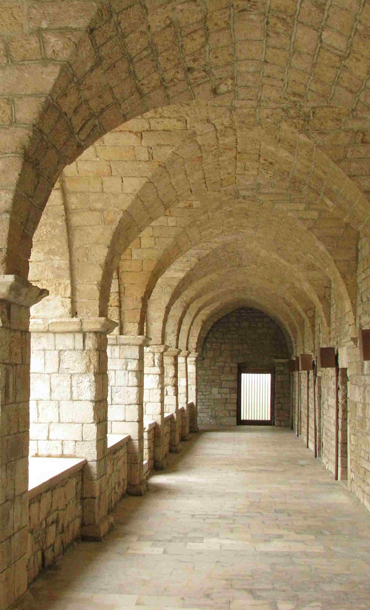Discover the city
The city of Trani is rich in a historical and cultural tradition that makes it, still today, one of the most intriguing points of interest in the whole of the Italian South and which offers one of the most beautiful and complete travel experiences one could wish for.

CATHEDRAL
The cathedral of Trani is one of the symbols of Puglia, and is a fine example of Apulian Romanesque. The current church was founded in 1097 and is named after St. Nicola Pellegrino; it was built on the ancient church of S. Maria della Scala and has had numerous construction phases. In the 1800s it was severely tampered with inside and was restored to its original elegance of form in the last century. The bell tower, 58.90 m high, in 1954 due to static problems was completely disassembled and subsequently rebuilt using the same material.
Near the cathedral, inside the Lodispoto and Addazi palaces, there is the diocesan museum, which houses the treasure of the cathedral composed of precious liturgical objects, various sacred vestments and wooden finds from the other churches of the diocese. Inside Palazzo Addazi there is a picture gallery, among the other works stands a fourteenth-century table of Byzantine inspiration representing parts of the life of St. Nicola Pellegrino patron of the city.

THE CASTLE
Chosen by Manfredi, son of Federico II, for the celebration of his wedding with Elena d’Epiro, the Castle of Trani is part of the Frederick castles circuit.
One of the most interesting examples in the Frederick castles circuit, built by Frederick II of Swabia, Trani Castle stands on the sea to fulfill the function of defending the city.
Famous for having been chosen by Manfredi, son of Frederick II of Swabia, as a casket to seal his marriage with Princess Elena d'Epiro, the manor preserves the charm of history but also of knightly legends that of voice in item has reached the present.
The Castle, especially during the summer, is the scene of numerous events, including the particular historical re-enactment of the Marriage of Manfredi that recreates the medieval atmosphere of the time.

HARBOR
The Port is the heart of Trani around which the jewels of the baroque and Romanesque architecture of the city are arranged, such as the Church of Santa Teresa or the Church of Ognissanti, and it is unquestionably among the most beautiful in the whole Adriatic coast, pleasant to see , suitable for walking and equipped for recreational tourism; in fact it is an obligatory stop for offshore sailing events and for national and international off-shore competitions.
It consists of a natural inlet defended by the two piers, that of S. Lucia and that of Sant 'Antonio, and especially the port area is full of pizzerias, pubs, characteristic restaurants that attract tourists and young people from the neighboring cities. In addition, the Port of Trani is a spectacular setting for city events, when in summer for the celebrations in honor of San Nicola Pellegrino, the patron saint of the city, the port becomes the place of transit for religious processions and an ideal site for admiring the fires of 'artifice.

THE HISTORICAL CENTER
In the area closest to the port, a few kilometers from the cathedral, there are some monumental buildings that are really worth a visit together accompanied by a guide. Among these, Palazzo Surdo, Palazzo Lopez and Palazzo Covelli stand out. Moreover, for those who want to let themselves go for a relaxing walk, the municipal villa is the ideal solution. This is the largest green space in the city that, in addition to granting relaxing moments in contact with nature, also offers glimpses of suggestive views that overlook the waterfront and allow you to embrace with a glance a large slice of territory that reaches the Monastery of Santa Maria Colonna.
One of the most evocative tours in Trani is certainly the Jewish quarter. In this narrow and interesting corner of the city, once there were four synagogues that were converted into Catholic churches in the sixteenth century. One of these, however, has recently been converted into a synagogue and still represents one of the most original and fascinating tourist destinations in the entire city. This is the Scolanova synagogue whose history contains a sort of inner torment that accompanied this building from its construction until the decision to return it to its original function in 2005. The building dates back to the 13th century and is completely characterized by a limestone masonry. In the ancient Jewish quarter, together with the Scolanova synagogue, the Sant’Anna museum also survived, also known as the Great Synagogue, which is one of the most important testimonies of the Jewish community of Trani.

DIOCESAN MUSEUM
The Museum of the Archdiocese of Trani-Barletta-Bisceglie-Nazareth was created by Archbishop Giuseppe Carata, in order to give a more adequate arrangement to the stone and sculptural material coming from demolitions made in the Cathedral and in other churches in the city of Trani.
Over the years its heritage has been greatly enriched with works and finds of great artistic and historical value. Thus, over the years, the institution has split its headquarters, dedicating the exhibition of the pictorial collection to the spaces of Palazzo Addazi and choosing the adjacent Palazzo Lodispoto as the new home for the remaining artistic heritage.
It is advisable to check the opening hours on the museum websites before the visit.

MONASTERY
Site on the homonymous peninsula about 2 km away. from the center of the town, the monumental complex dates back to the early 1100s. The Monastery was first inhabited by the Benedictines and then, from 1427 to 1867, by the Franciscans; abandoned for long decades it has been restored to its new splendor by the Municipality which has made it the venue for cultural exhibitions and meetings.
The church has a basilical plan, divided into three naves by square-section pillars; of particular interest is the rose window of the main facade, dating back to the 12th century, and a wooden Crucifix from the 15th century. there guarded, for which the Tranesi hold particular devotion and that is celebrated on May 3 with a solemn procession of boats.